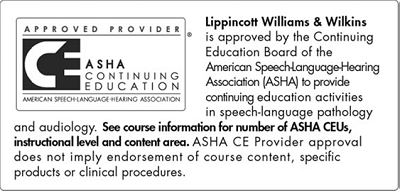{{ (moduleVm.actions && moduleVm.changeStatus) ? moduleVm.status : '' }} Personalized Early AAC Intervention to Build Language and Literacy Skills: A Case Study of a 3-Year-Old with Complex Communication Needs
Activity Steps
Description
Speech-Language Pathologists (SLPs) will learn how personalized early augmentative alternative communication (AAC) interventions can benefit a child with complex communication needs. SLPs will learn how each system is selected and the benefits of personalized AAC for children with complex communication needs. The effectiveness of personalized AAC on literacy development for children with complex communication needs will be explained through use of a case study which includes use of a personalized AAC intervention over a six-month period for a 3-year-old girl with developmental delay and complex communication needs. Accreditation
This course is offered for 0.15 ASHA CEUs
(Intermediate Level, Professional Area).
Purpose of Activity
To gain knowledge about how personalized early augmentative alternative communication (AAC) interventions can benefit a child with complex communication needsLearning Objectives
After completing this continuing education activity you will be able to:
- Describe personalized augmentative alternative communication (AAC) and how each system is selected.
- Summarize the benefits of personalized AAC for children with complex communication needs.
- Identify the effectiveness of personalized AAC on literacy development for children with complex communication needs.
Disclosures
The contents of this paper were developed under grants to the Rehabilitation Engineering Research Center on Augmentative and Alternative Communication (The RERC on AAC) from the U.S. Department of Health and Human Services, National Institute on Disability, Independent Living, and Rehabilitation Research (NIDILRR): grant # 90RE5017 (2014-20) and grant #90REGE0014-01-00 (2020-25). The third author was supported through a personnel preparation grant funded by the Office of Special Education Programs of the U.S. Department of Education (grant #H325K170130). The contents do not necessarily represent the policy of the funding agencies, and endorsement by the federal government should not be assumed. We also wish to gratefully acknowledge the funding received from the Hintz Family Endowment to support the AAC program at Penn State University. Most importantly, we wish to thank "Jessica" and her parents for allowing us to be a part of their lives and for graciously consenting to share their experiences.
Janice Light, Ph.D
Financial: Dr. Janice Light disclosed receipt of money paid to her institution by the National Institute on Disability, Independent Living, and Rehabilitation Research grants #90RE5017 and 90REGE0014.
Nonfinancial: Dr. Janice Light's research is focused on improving communication outcomes and enhancing quality of life for individuals who have complex communication needs, including individuals with autism spectrum disorder, cerebral palsy, Down syndrome, intellectual/ developmental disabilities and other special needs. These individuals benefit from augmentative and alternative communication (AAC) (e.g., signs, communication boards, speech generating devices, mobile technologies with AAC apps).
Credits:
- ASHA 0.15 CEU